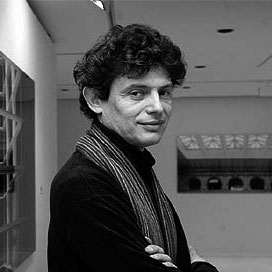Ballester and Bonet made a joint trip to this great metropolis of the south, in 2007, a trip in which they established a speech of complicity, intellectual exchange, and generous debate of points of view and looks when choosing shots. The book reflects the journey of two flâneur adrift through the streets of Sao Paulo, in search of their particular Nadja.
The text of Bonet is preceded by a brief text by Simonetta Persichetti, who is quickly accompanied by essential guests in her vision of the city as Walter Benjamin. I would add as well his contemporary Erich Mendelsohn, of whom I always remember his impressive dialectical images on his trips to the American city, although it is true that in this second the present is moved to the future in a city with few past references, especially because of the youth of the city. In the case of Sao Paulo, a century of Modernity allows us to look back. In any case, and as Bonet advances at the beginning of his text, Ballester's work is what in the 1920s called a city photo or urban symphony.
As it happened to Mendelshon, this book is the result of several trips, Bonet and Ballester, in which there is a rapprochement and finally a crush on the city of the south, a silent love, in which the city is represented as quiet.
"The fervor is in its buildings, in its passages, in its geometric forms: a visual narrative not of Sao Paulo, but of the city, Ballester understands to be Sao Paulo,"
Simonetta Persichetti.
The text of Bonet narrates the construction of the trip he had to see the exhibition of José Manuel Ballester, which ended up being considered not as a retrospective of the previous work but as a fresher and recent vision to include the vision of the Madrilenian over the city of Sao Paulo. It was reflected in an exhibition in 2010 in the Pinacoteca do Estado, curated by Bonet and titled "Fervor da metrópole" (Fervor of the metropolis).
A trip which lasted a few days exhaustively prepared, and that made a special review of the city's architecture in the twentieth century. This preparation generated knowledge which served as a basis for the process of image capture, the result of which allowed Ballester to make a novel, different graphic contribution of a city so profusely photographed. Inspiration always has a flat ass.
Bonet's text is a delicious description of concomitant causes, encounters, memories, reunions walks, and talks with friends ... As he says, a "rotten pot" which also includes poems and allows us to understand the visual construction the Ballester images show in the book.
The text is also the narrative about an architectural, imaginary vision of the history of the Brazilian city, which is also partly shown by Ballester. From the impressive view of the Copan building at dusk to the park Ibirapuera, Niemeyer is a repeated protagonist. Also works by Burle Marx, Mina Klabin, Gregorio Warchavchik, Flávio de Carvalho, David Libeskind, constantly Le Corbusier, Paulo Mendes da Rocha and of course much mentioned Lina Bobardi ... with houses like Vila Mariana, apartments of workers, Avenida Paulista, The legendary Livraria Cultura, obviously also the Masp, the portico of the Prada do Patriarca or its store Forma, Estaçao da Luz and more Lina Bo Bardi in the cultural and social centre Sesc Pompeya, park, houses, buildings and avenues in a litany almost Infinite and impressive, if one thinks that it is the narrative of the drifts of a week in the case of Bonet or of two in the case of the "photographer and painter" José Manuel Ballester.
After reading Bonet Ballester's images, I can say without knowing the city directly that despite the drunkenness which during all these years has come to my eyes of images of that city, coming up to dream I have visited, seeing the images of Ballester the city seems different, masterfully beautiful and new. An absolutely recommendable book.


































